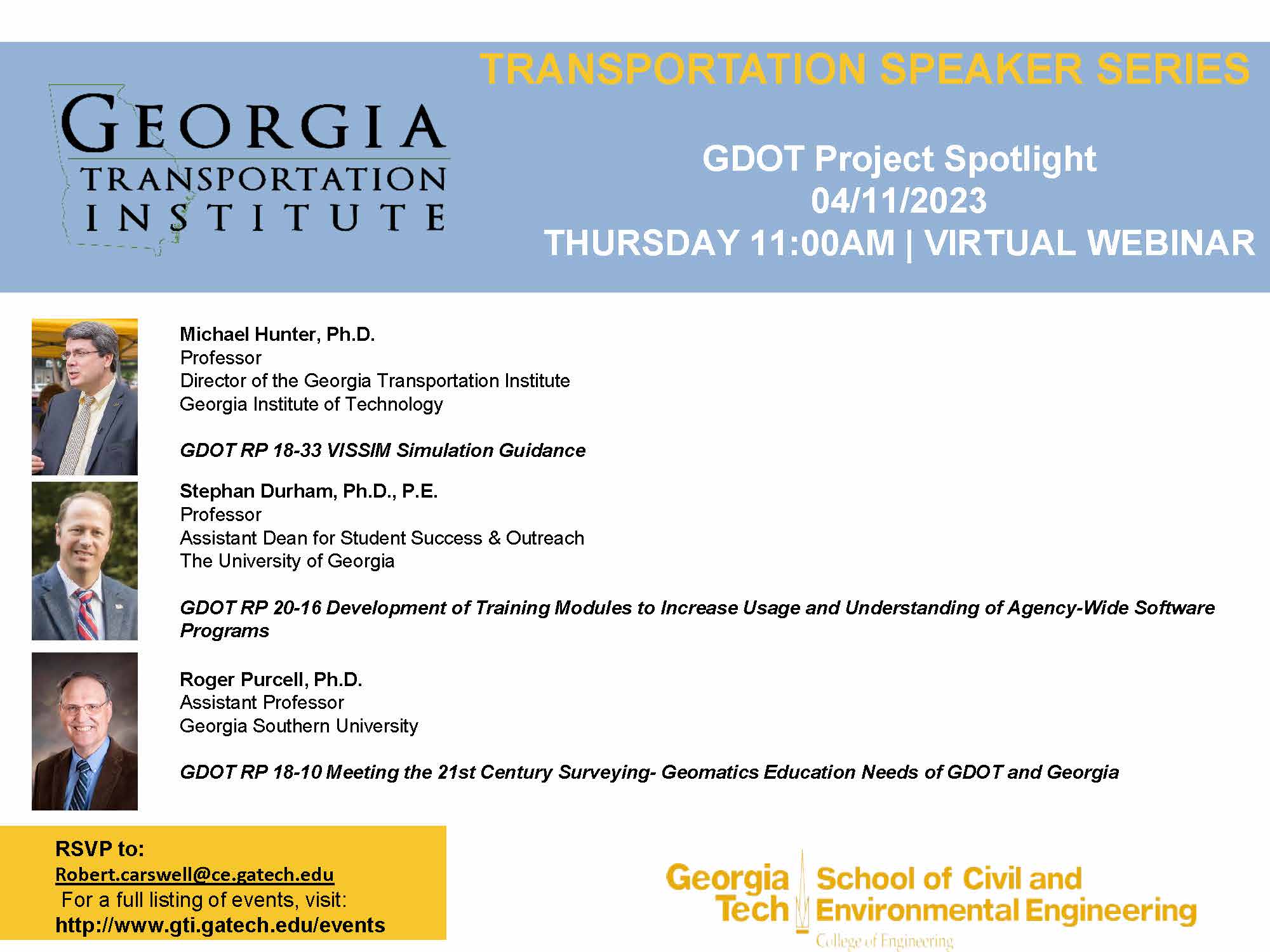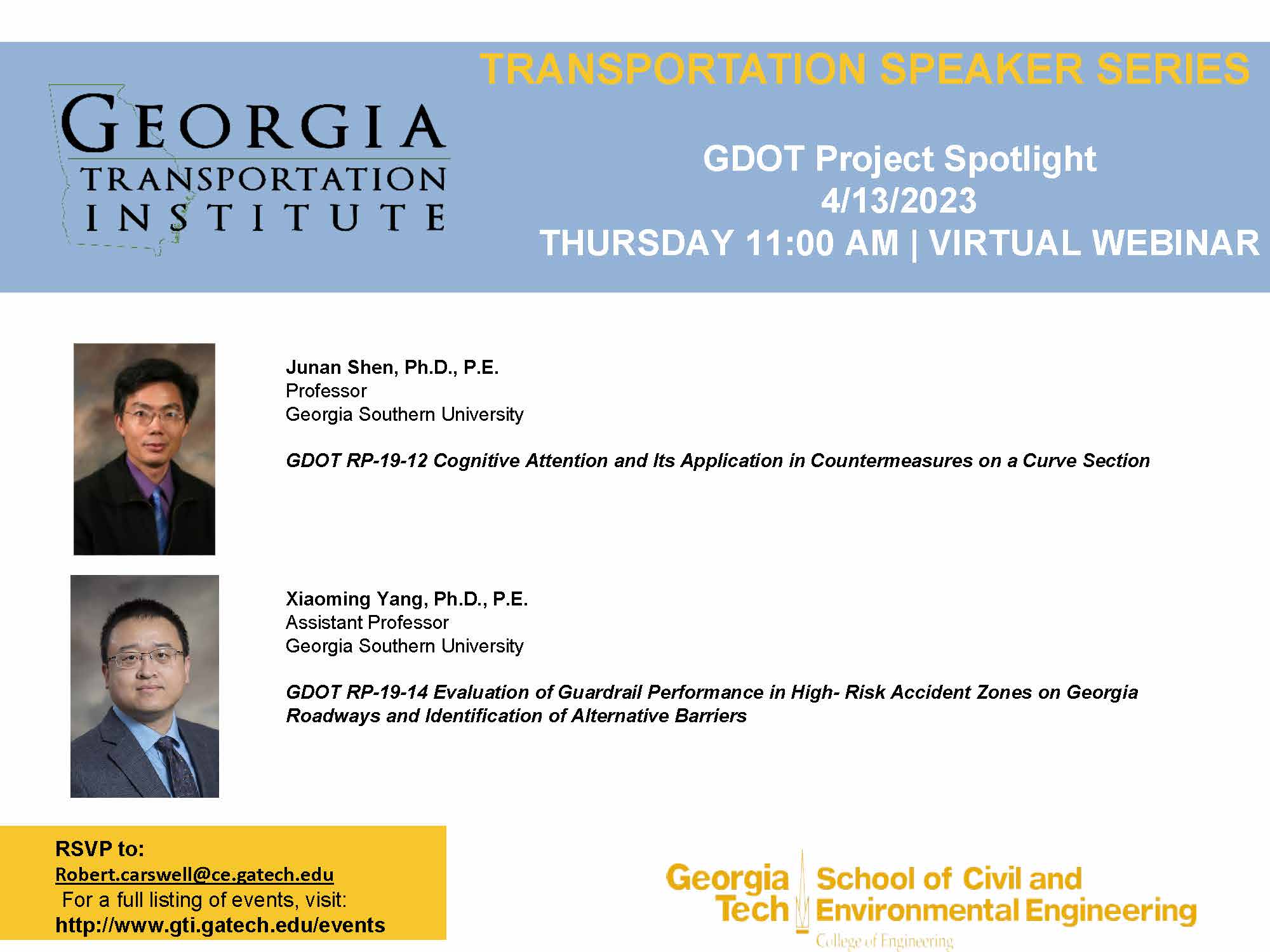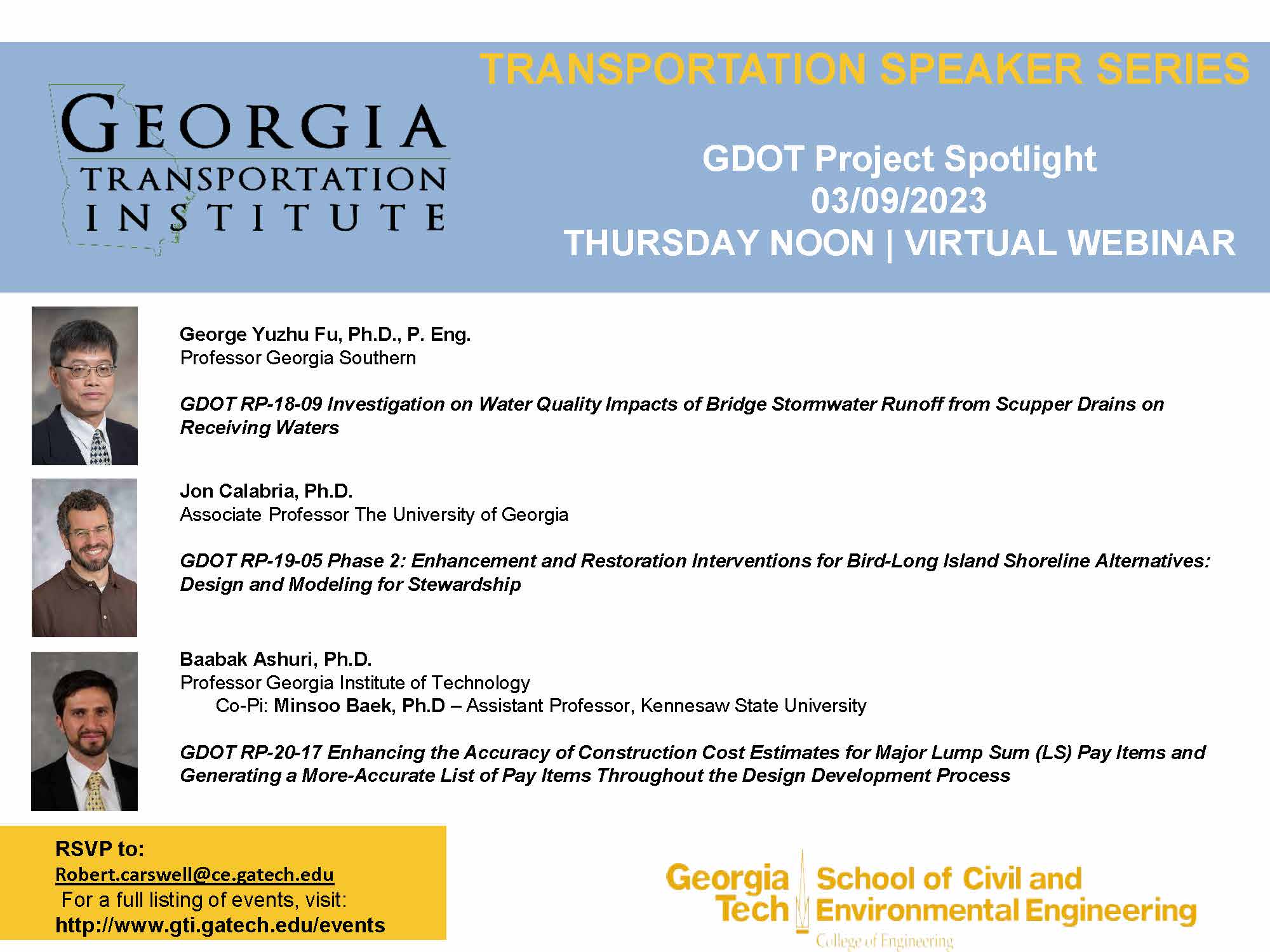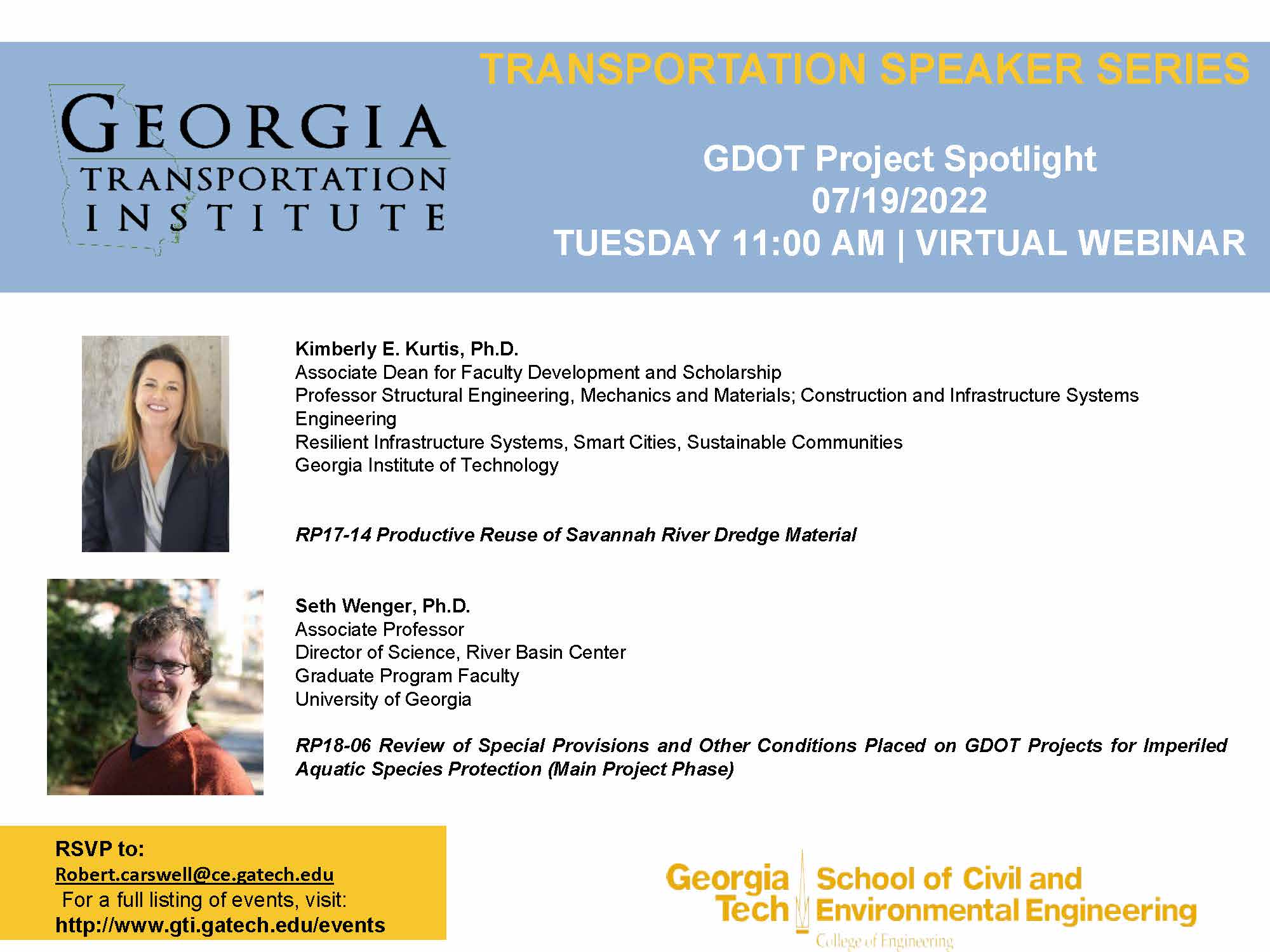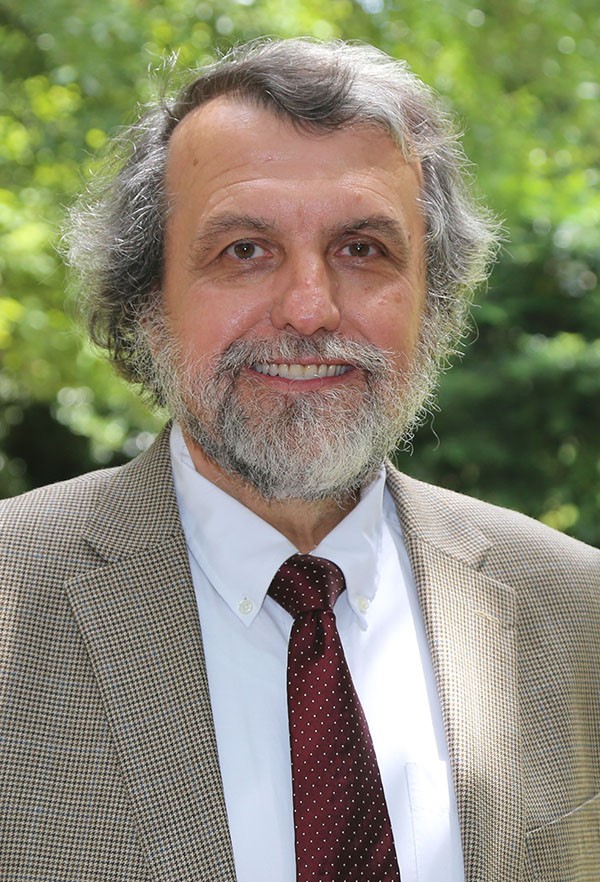Thursday June 15th, 2023 the Georgia Transportation Institute will hosted a 1-hour webinar that spotlighted two recently completed GDOT Research projects. Each project had maximum of a 15-minute presentation, with a short time afterward for questions.
You can join the event by using the Microsoft Teams link below:
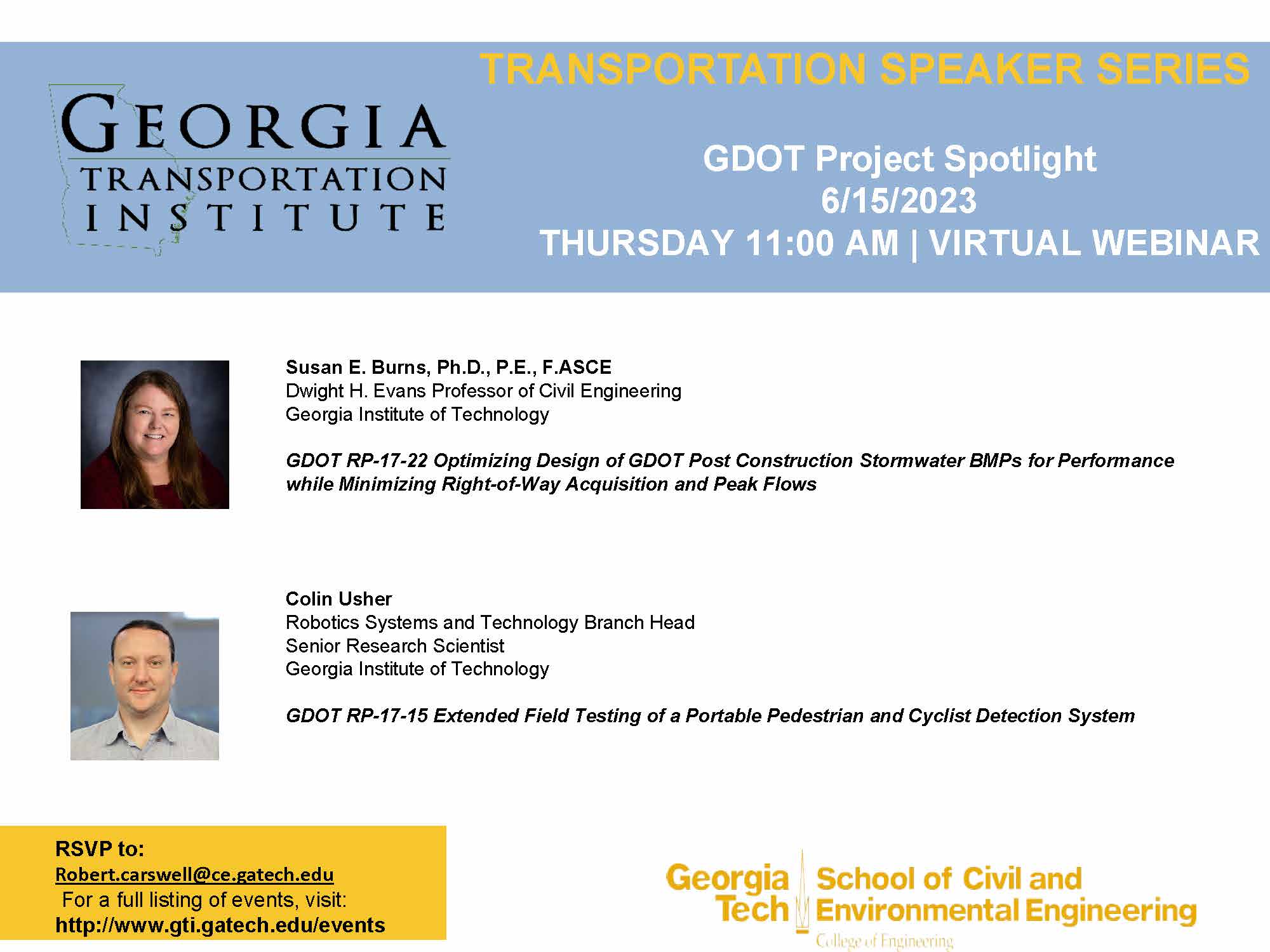
Presenter: Susan E. Burns, Ph.D., P.E., F.ASCE, Dwight H. Evans Professor of Civil Engineering
Director of the Georgia Transportation Institute
Georgia Institute of Technology
Susan E. Burns, Ph.D., P.E., F.ASCE is the Dwight H. Evans Professor in the School of Civil and Environmental Engineering and Associate Chair for Administration and Finance at the Georgia Institute of Technology in Atlanta, Georgia, USA. Dr. Burns earned a B.C.E. Civil Engineering (‘90), M.S. Civil Engineering (‘96), M.S. Environmental Engineering (‘96), and Ph.D. in Civil Engineering (‘97), all from Georgia Tech. Dr. Burns’ research focuses on applications in geoenvironmental engineering including sustainability and beneficial use of waste materials; erosion, infiltration, and stormwater treatment on roadway rights-of-way; bio-mediated ground improvement; and fundamental chemical and engineering behavior of soils. Funding for her research group has come from a range of agencies, including the National Science Foundation, the US Department of Energy, the US Army Corps of Engineers, the US Department of Education, the Virginia Transportation Research Council, the Georgia Department of Transportation, Southern Company, and other industrial sources.
Dr. Burns is a current member of the Committee on Corrosion of Buried Steel at New and In-Service Infrastructure (National Academies of Sciences, Engineering, and Medicine), and is a past member of the National Research Council’s (NRC) Standing Committee on Geological and Geotechnical Engineering, and a past member of the NRC’s Committee on Assessment of the Performance of Engineered Waste Containment Barriers. Her work on the beneficial use of waste materials was recognized with the Georgia Power Distinguished Professorship (2013 – 2018), and she frequently lectures on beneficial use of waste materials.
Within the School of Civil and Environmental Engineering, Dr. Burns currently serves as Associate Chair for Administration and Finance, where she leads administration of the School’s budget, staff, facilities, and information technology. She previously served as the School’s Associate Chair for Undergraduate Programs, where she oversaw all aspects of the undergraduate degrees in Civil and Environmental Engineering, include ABET accreditation. She has had fellowships in the GT Provost’s Emerging Leader Program, the GT Inclusive Leaders Academy, and as a Diversity and Inclusion Fellow, where she is passionately committed to support of underrepresented minorities within engineering. Roughly half of her graduate students are members of underrepresented groups in engineering (women, BIPOC, Latinx).
Dr. Burns is a fellow of the American Society of Civil Engineers, a recipient of the National Science Foundation CAREER award, the Arthur Casagrande Professional Development Award (ASCE), and she was named the 2020 Engineer of the Year by the Georgia Society of Professional Engineers (NSPE-GA). In 2021, Dr. Burns received the Class of 1940 W. Howard Ector Outstanding Teacher Award, which is Georgia Tech’s highest award for teaching. Most recently, Dr. Burns was selected as a Fellow in the Georgia Tech Faculty Executive Leadership Academy and was named one of the 100 most influential women in Georgia Engineering by the American Council of Engineering Companies of Georgia.
Title: GDOT RP-17-22 Optimizing Design of GDOT Post Construction Stormwater BMPs for Performance while Minimizing Right-of-Way Acquisition and Peak Flows
Abstract:
The objectives of this study were to evaluate the performance of stormwater best management practices (BMPs) used for stormwater quantity and quality control. Three field sites were tested to quantify hydraulic conductivity, infiltration, and solids removal efficiency. Removal efficiencies ranged from 12% to 35% of infiltrated runoff for VFS ranging from 15 ft. to 75 ft. long with slopes varying from 2% to 6%. For suspended solids removal, the VFS has the potential to remove between 21% and 43% when their design lengths range from 15 ft. to 75 ft long with slopes varying from 2% to 6%. It is recommended that partial credit be given for solids removal in filter strips that are shorter than the required 15 feet, and that filter strip designs incorporate the shallow grassed highway shoulder.
Presenter: Colin Usher
Robotics Systems and Technology Branch Head
Senior Research Scientist
Georgia Institute of Technology
Colin Usher is a Senior Research Scientist and Branch Head of the Robotics Branch in the Intelligent Sustainable Technologies Division (ISTD) housed in the Aerospace, Transportation and Advanced Systems Laboratory (ATAS) at Georgia Tech Research Institute (GTRI). Mr. Usher joined GTRI in 2020 with a bachelor’s in computer science from the University of Georgia. One of his first projects he supported was the development of an adverse visibility warning system for the GDOT. He obtained a master’s degree in systems engineering from Southern Polytechnic State University in 2010. In the following years, he has performed as a technical lead and eventually a project manager on several efforts supporting clients ranging from industry, agriculture, transportation, and military. Most recently, his interest is in developing novel human/robot interfaces utilizing augmented and virtual reality systems.
Title: GDOT RP-17-15 Extended Field Testing of a Portable Pedestrian and Cyclist Detection System
Abstract:
The objective of this project was to enhance the capabilities of the pedestrian tracking system by adding support for detection and tracking of cyclists and vehicles, in addition to generating a set of tools to aid in analysis. Secondary tasks explored methods of enhancing the system capability for added value. The system analyzes the collected video data and automatically identifies and characterizes the number of pedestrians, vehicles, and cyclists and their behavior at midblock and intersection locations (specifically, their crossing locations and frequency). The system is designed to be portable to support data collection in multiple locations. Key conclusions from this study are:
1) A detection and tracking software system capable of creating and logging trajectories for pedestrians, vehicles, and cyclists was implemented and tested
2) Field testing of detection algorithms yielded accuracy between 90% and 95%, but count accuracy suffered at 53%
3) A set of powerful analysis tools was developed to allow in-depth analysis of results
Date and time:
Thursday, June 15, 2023 – 11:00 to 12:00
Location of Event:
Event Type:
Seminars

